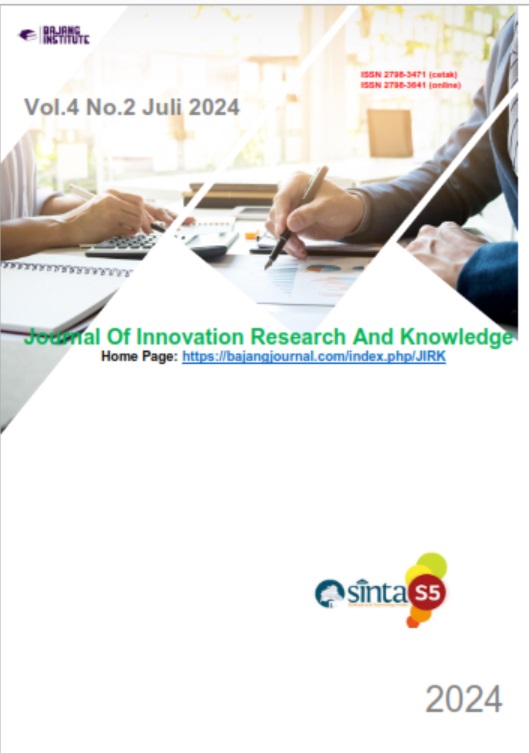EFFECTIVE COMMUNICATION PRINCIPLES IN THE QURAN: FOSTERING HARMONIOUS INTERPERSONAL RELATIONSHIP
DOI:
https://doi.org/10.53625/jirk.v4i2.7908Keywords:
effective communication, interpersonal relationships, Quranic principlesAbstract
This study aims to identify the principles of effective communication found in the Quran and evaluate their application in daily life to build harmonious interpersonal relationships. While extensive research has been conducted on effective communication, studies specifically examining Quranic communication principles and their practical implementation remain limited. The Quran, as the holy book of Islam, not only provides spiritual guidance but also offers communication principles that can address contemporary communication challenges. This study uses a qualitative approach to explore these principles. Primary data is derived from Quranic verses related to communication, while secondary data includes Quranic tafsirs, books on Islamic communication, and academic articles on effective communication theories. Text analysis is conducted to categorize verses based on themes such as honesty (qaulan sadidan), kindness (qaulan ma’rufan), wisdom (qaulan balighan), empathy and compassion (qaulan layyinan), and respect (qaulan kariman). The findings reveal that Quranic communication forms align closely with the effective communication theories of Stewart L. Tubbs and Sylvia Moss, and the interpersonal communication theories of Muhammad Budyatna and Leila Mona Ganiem. These principles emphasize understanding, honesty, clarity, respect, and gentleness, which collectively enhance communication quality and interpersonal relationships. This study provides practical solutions for improving communication in a complex and diverse society, recommending the adoption of Quranic communication forms in daily practices to foster understanding, build trust, and create a harmonious communication environment.
References
Adler, R B, and R F Proctor. 2013. Looking Out, Looking In. Cengage Learning. https://books.google.co.id/books?id=Ofi0eJAHyykC.
Ali, Abdullah Yusuf. 2004. The Meaning of The Holy Qur’an. Amana Publications.
Andersen, Peter A, and Laura K Guerrero. 1996. “Principles of Communication and Emotion in Social Interaction.” In . https://api.semanticscholar.org/CorpusID:152205101.
Ar-Rifai, Muhammad Nashib. 2001. Kemudahan Dari Allah Ringkasan Tafsîr Ibnu Katsîr, Penerjemah: Syihabuddin. Jakarta: Gema Insani.
Az-Zuhaili, Wahbah. 2005. At-Tafsir al-Munîr. Beirut: Dâr al-Fikr.
Baym, Nancy K. 2015. Personal Connections in the Digital Age. 2nd ed. Polity.
Budyatna, Muhammad, and Leila Mona Ganiem. 2021. Teori Komunikasi Antarpribadi. 2nd ed. Jakarta: Prenada Media Grup (Kencana). https://prenadamedia.com/product/teori-komunikasi-antarpribadi-edisi-kedua/.
Butler, Emily A, and James J Gross. 2009. “Emotion and Emotion Regulation: Integrating Individual and Social Levels of Analysis.” Emotion Review 1, no. 1 (January): 86–87. https://doi.org/10.1177/1754073908099131.
Chiad, Muayyad Omran. 2020. “A Semantic Investigation of Non-Verbal Communication in the Qura’nic Discourse.” Transylvanian Review 27, no. 48 (June). https://consensus.app/papers/investigation-nonverbal-communication-quranic-chiad/45c69b93e6b95ec1b946c13720216e31/?q=Non-verbal+communication+in+Islam.
Clearfield, Melissa W, Christine N Osborne, and Molly Mullen. 2008. “Learning by Looking: Infants’ Social Looking Behavior across the Transition from Crawling to Walking.” Journal of Experimental Child Psychology 100, no. 4: 297–307. https://doi.org/https://doi.org/10.1016/j.jecp.2008.03.005.
Creswell, John W. 2013. Qualitative Inquiry and Research Design: Choosing Among Five Approaches. Edited by 3rd. Thousand Oaks, CA: SAGE Publications, Inc.
Derks, Daantje, Agneta H Fischer, and Arjan E R Bos. 2008. “The Role of Emotion in Computer-Mediated Communication: A Review.” Computers in Human Behavior 24, no. 3: 766–85. https://doi.org/https://doi.org/10.1016/j.chb.2007.04.004.
Esack, Farid. 2002. The Qur’an: A Short Introduction. Oneworld Publications.
Fredrickson, Barbara L. 2001. “The Role of Positive Emotions in Positive Psychology: The Broaden-and-Build Theory of Positive Emotions Perspectives on Emotions and Affect NIH Public Access.” Am Psychol 56, no. 3: 218–26.
Hamka. 2017. Tafsir Al-Azhar. Jakarta: Gema Insani Press.
Johnson, David W. 2021. Reaching Out: Interpersonal Effectiveness and Self-Actualization. 11th ed. Pearson.
Johnson, David W., and Frank P. Johnson. 2021. Joining Together: Group Theory and Group Skills, 12th Edition. Pearson.
Lawlor, Debbie A, Kate Tilling, and George Davey Smith. 2016. “Triangulation in Aetiological Epidemiology.” International Journal of Epidemiology 45, no. 6 (December): 1866–86. https://doi.org/10.1093/ije/dyw314.
Leaman, Oliver. 2006. The Qur’an: An Encyclopedia. Routledge.
Levine, Timothy, Kelli Asada, and Hee Park. 2006. “The Lying Chicken and the Gaze Avoidant Egg: Eye Contact, Deception, and Causal Order.” Southern Communication Journal 71, no. December (December): 401–11. https://doi.org/10.1080/10417940601000576.
Rahman, Fazlur. 2009. Major Themes of the Quran. 2nd ed. Bibliotheca Islamica. https://books.google.co.id/books?id=S41LPgAACAAJ.
Shekarbeygi, Narges. 2020. “Principles Governing Personal and Social Relationships Affecting Spiritual Health in the Holy Quran.” International Journal of Social Science Research and Review 3, no. 3 (September): 9–18. https://doi.org/10.47814/ijssrr.v3i3.42.
Shihab, Muhammad Quraish. 2002. Tafsir Al-Mishbah. Lentera Hati.
Tannen, Deborah. 2007. You Just Don’t Understand: Women and Men in Conversation. 1st ed. William Morrow Paperbacks.
Tubbs, S L, and S Moss. 2002. Human Communication: Principles and Contexts. McGraw-Hill Education. https://books.google.co.id/books?id=ZoiAAAAACAAJ.
Turkle, Sherry. 2015. Reclaiming Conversation: The Power Of Talk In A Digital Age. New York: Penguin Books.













